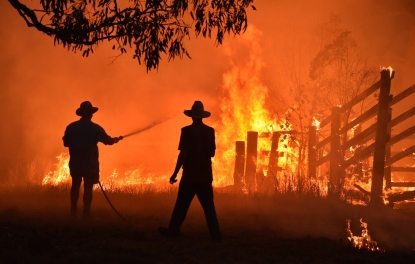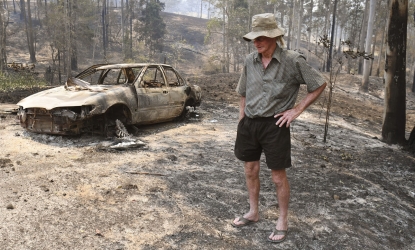The worst is yet to come?
Sydney -- Firemen are saying that certain of the bushfires we have in Australia right now will burn for six months. Fires are a natural occurrence in Australia, they happen every year. But this year has been particularly bad.
 An aerial view of the bushfire burns out of control in the Richmond Valley, of the New South Wales on November 26, 2019. (AFP / Saeed Khan)
An aerial view of the bushfire burns out of control in the Richmond Valley, of the New South Wales on November 26, 2019. (AFP / Saeed Khan)It’s an accumulation of things I suppose -- we’re in the middle of a drought, there’s no rain, temperatures are rising, there’s excess vegetation that acts as fuel. But all of these have been exacerbated by climate change. Everything is just getting hotter. I’ve been here for five years and I lived here 30 years ago and I’ve never seen it this bad. I’ve never seen Sydney enveloped by smoke from the blazes.
 Smoke from bushfires blanket Sydney on November 19, 2019. (AFP / Peter Parks)
Smoke from bushfires blanket Sydney on November 19, 2019. (AFP / Peter Parks)
The heat and the noise of a bushfire are very powerful. You really feel their intensity. It’s quite intimidating, even though you’re wearing protective gear and you’ve gone through training courses, and you’re behind the firefighters.
 A firefighter defends a property from a bushfire at Hillville near Taree, 350km north of Sydney on November 12, 2019. (AFP / Peter Parks)
A firefighter defends a property from a bushfire at Hillville near Taree, 350km north of Sydney on November 12, 2019. (AFP / Peter Parks) Firefighters defend a property from a bushfire at Hillville near Taree, 350km north of Sydney on November 12, 2019. (AFP / Peter Parks)
Firefighters defend a property from a bushfire at Hillville near Taree, 350km north of Sydney on November 12, 2019. (AFP / Peter Parks)
The noise is a roar and it intensifies depending on how strong the wind is. Most of the time when you shoot a fire, it’s coming toward you. To get the best pictures, you have to be in front of it. The heat is really strong, you’re always aware of it. The wind is always gusting, it’s never constant.
 A helicopter drops water on a homestead as bushfires impact on farmland near the small town of Nana Glen, some 600kms north of Sydney on November 12, 2019. (AFP / William West)
A helicopter drops water on a homestead as bushfires impact on farmland near the small town of Nana Glen, some 600kms north of Sydney on November 12, 2019. (AFP / William West)When the wind gusts get really strong, it kind of whooshes and the flames go higher and hit the tops of the trees. These are gum trees, which are full of oil and are very incendiary because of this. So when the flames reach the tops of the trees, they just kind of explode. It’s an awesome and intimidating sight to behold. You’re wearing the whole getup -- goggles, helmet, fire jumpsuit, boots. And still you can feel very vulnerable.
 Residents defend a property from a bushfire at Hillsville near Taree, 350km north of Sydney on November 12, 2019. (AFP / Peter Parks)
Residents defend a property from a bushfire at Hillsville near Taree, 350km north of Sydney on November 12, 2019. (AFP / Peter Parks)One of the most memorable moments I had covering these bushfires was on a day when a reporter and I drove on a side road. We were trying to get to a place that had been burned down the day before to take some pictures. The fire was in front of us. But as we drove along, the fire suddenly appeared on the right-hand side. It must have changed with the wind. We were wearing our protective gear and we were in a car, but we could feel the heat seeping in through the metal.
The flames were really low and then they reached trees that were around 15 meters high. And when they reached the tops of those trees, they must have burned through to the oil inside and the trees just ignited. It was quite a sight -- these huge trees just igniting at the top. It’s called crowning and the effect is really amazing. But a situation like that is very unpredictable. The trees can fall and you never know which way they’ll tumble.
 People watch as the fire front approaches their home at Nabiac, some 350kms north of Sydney, on November 15, 2019. (AFP / William West)
People watch as the fire front approaches their home at Nabiac, some 350kms north of Sydney, on November 15, 2019. (AFP / William West)The drive on this road that was completely engulfed by flames. We had no visibility forward or backward. You have no idea what might happen next. It’s exciting but it’s also completely dangerous.
 A bushfire burns outside a property near Taree, 350km north of Sydney on November 12, 2019. (AFP / Peter Parks)
A bushfire burns outside a property near Taree, 350km north of Sydney on November 12, 2019. (AFP / Peter Parks)That said, I have to say that I never felt that we were really in real danger during coverage. We had a lot of training and we learned that you always have to leave yourself an escape route. In this particular situation, the fire was on the right, but there was always an escape route on the left.
 A man uses a wet towel to help put out flames as they encroach on farmland near the town of Taree, some 350kms north of Sydney, on November 14, 2019. (AFP / William West)
A man uses a wet towel to help put out flames as they encroach on farmland near the town of Taree, some 350kms north of Sydney, on November 14, 2019. (AFP / William West)Another thing that struck me was seeing the smoke over Sydney from these fires. It really drove home just how serious of a problem that this has become. And summer here hasn’t even started yet.
 Surfers and swimmers at Bondi Beach are seen through a smokey haze which blankets Sydney on November 21, 2019. (AFP / Peter Parks)
Surfers and swimmers at Bondi Beach are seen through a smokey haze which blankets Sydney on November 21, 2019. (AFP / Peter Parks)The worst could very well be yet to come.
This blog was written with Yana Dlugy in Paris.
 Rick Wright inspects the damage next to his house at Nabiac, some 350kms north of Sydney, on November 15, 2019. (AFP / William West)
Rick Wright inspects the damage next to his house at Nabiac, some 350kms north of Sydney, on November 15, 2019. (AFP / William West)






